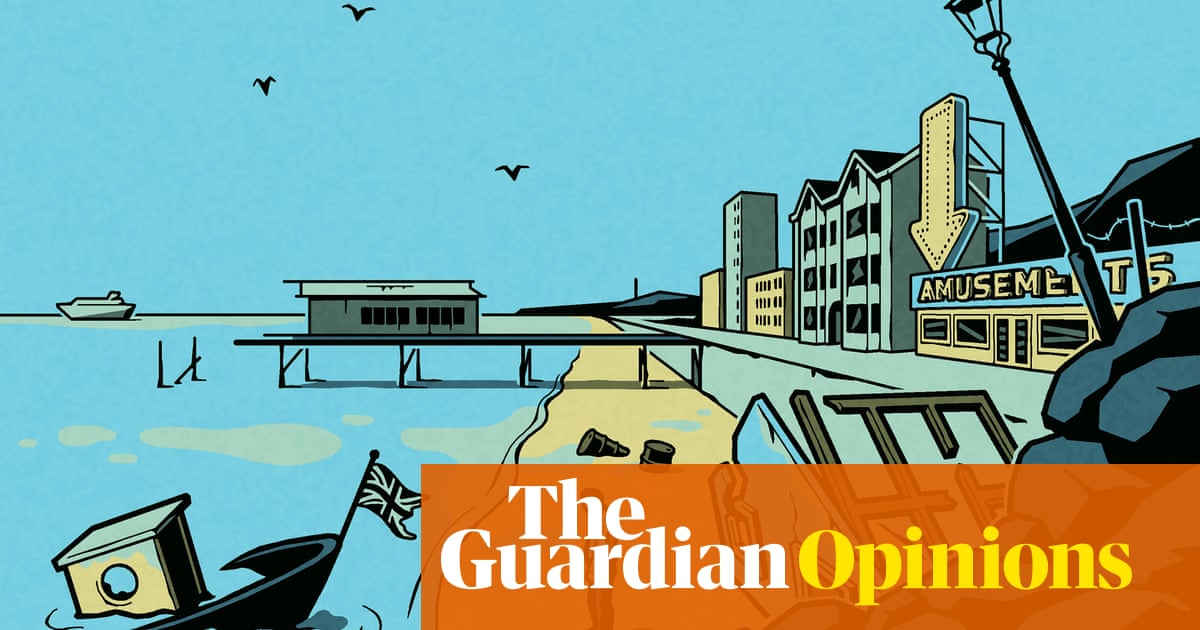
About a decade ago, politicians and journalists were suddenly confronted with an issue that had always festered at the edge of the national conversation: the dire state of England’s seaside towns, and their deep social problems.
The referendum that would pull us out of the EU was a couple of years away, but one of the key things that made it happen was already plain to see: the rise of the UK Independence party, and a surge of grievance and complaint that had particularly strong roots on the East coast. In 2014, the faded Essex resort of Clacton held the byelection that resulted in the Tory turncoat Douglas Carswell becoming the first of Ukip’s two elected MPs. His new party was doing equally brisk political business in coastal towns clustered in Norfolk and Lincolnshire.
When the vote for Brexit came, such places as Blackpool, Great Yarmouth, Canvey Island and Margate were among the leave side’s enthusiastic sources of support. As Nigel Farage and his friends endlessly said, many people in those towns were anxious and angry about immigration. But as I well knew from repeated reporting trips, what they tended to talk about most passionately was stuff that Ukip rarely mentioned: dreadful public transport, poor housing, nonexistent opportunities for young people, and local economies that effectively died for half the year.
In the wake of the result, politicians and journalists maintained a sort of guilt-stricken interest in the kind of “left-behind” places that looked out to sea. But then, as the 2019 election came into view, there was a shift. The most vivid political stories suddenly seemed to centre on the old coalfields and former factory towns grouped into the so-called “red wall”. That continuing story has since been joined by that of the supposed “blue wall”: Tory-held seats in the south of England where disgruntled remainers are looking to other parties. There have been a few rather laboured attempts to conceptualise a “sea wall” centred on coastal constituencies, but they have failed to catch on: the plight of seaside towns remains as clear as ever, but they have once again fallen back to the political margins.
Among plenty of others, this is one of the stories that runs through a brilliant new book titled The Seaside: England’s Love Affair, by the former Guardian writer Madeleine Bunting. It is a travelogue, an impressive work of social history, an affectionate celebration and much more besides. But a grim English irony burns through almost every page: the fact that the places many of us still associate with leisure, noisy enjoyment and the health-giving wonders of sea air are also full of isolation, misery and poor health.
Each chapter has a sobering passage that recounts basic facts. “Over 80% of the residents of Skegness and Mablethorpe live in areas categorised as the 20% most deprived in England. Around a third of residents have no or low qualifications … Scarborough’s quaint streets translate into a tragic set of health statistics on the diseases of despair: suicide in the town is 61% higher than the national average, and hospital admissions are 60% higher … Despite the success of Margate’s regeneration, parts of the centre of the town are still among the most deprived in the country; it has three areas in the top half per cent on the index of multiple deprivation.”
What all these numbers reflect is the reality of living on the edge, in every sense. Coastal towns are often not just distant from Westminster, but also on the periphery of local government districts, and therefore neglected even by their own councils. They tend not to have any institutions of higher education. And their public transport is largely terrible: this week’s story about the nationalisation of the failing train operator TransPennine Express, for example, is not only about Leeds, Sheffield and Manchester, but places where dire rail transport compounds glaring economic problems: Redcar, Scarborough, Cleethorpes, Hull, Grimsby.
Such are the results of a neglect that is evident even when people in positions of power are in a mood to help. One of the most telling features of last year’s levelling up white paper was a seemingly reflex tendency to fold coastal areas into generalised descriptions of places with problems – “Urban areas and coastal towns”, “former industrial centres and many coastal communities” – and thereby underplay their very specific issues. The same sense of condescension surrounds the government’s £229m coastal communities fund. As one of the most damning parts of Bunting’s book explains, it has been spread pathetically thinly: £1.6m to renovate the centre of Bognor Regis, £1.4m for “a visitor centre at Walton-on-the-Naze”, £1.2m for Hastings’ new “food court”.
And then there are the government’s much-hyped plans for so-called freeports, replete with promises of thousands of new jobs. These deregulated, low-tax zones – still shrouded in secrecy – are the cheapest kind of regeneration option, reflecting the old laissez-faire idea that if the state steps out of the way, it will somehow open the way to dynamism and innovation. But without huge improvements in transport, housing, training, education and all the rest, the kind of employers who might offer more than low-paid, precarious work will never pitch up. Besides, the plans are centred on a large handful of existing commercial ports, not coastal communities in general: even if their supposed miracles materialise, they will not touch most of the UK’s coastline.
Elsewhere, there are glimmers of hope. The annual £28bn the Labour party is still pledging to spend on new climate measures – which sits alongside other plans for government-led investment in deprived areas – will have clear benefits for coastal places, not least because of the centrality to the plans of offshore wind. Its promised “take back control” bill will at least increase the responsibilities of local councils, and thereby bring some decisions closer to the places they affect. But as ever, more radical thinking might be a good idea. Within central government, coastal communities should surely have their own dedicated minister. Clusters of seaside towns should perhaps be grouped into federations led by mayor-like figures, and given responsibility for collective regeneration plans, along with the kind of substantial spending power that Westminster politicians never like to talk about.
Last summer, I took a family holiday not far from Minehead, a coastal town on the edge of Somerset long associated with deprivation, scarce job opportunities and a sense of being woefully cut off. It is actually a gloriously located place, overlooked by a spectacular headland, with an elegantly wide main street and a lovely beach. It is 60 miles from Bristol and about 40 from Exeter: in the era of working from home, it could thrive.
But besides steam trains that slowly transport tourists across the nearby countryside, its 12,000 residents have no rail service: the town’s station closed in 1971. As with so many other places, choices were made in distant centres of power that condemned it to long years of stagnation and decay. Now, instead of fixating on coastal towns one day and forgetting them the next, could we not just give them what they need?
John Harris is a Guardian columnist












